Sable Ferret (original) (raw)
“The Sable Ferret is the most common of the pet ferrets.”
Though it requires more upkeep than a dog or a cat, the sable ferret makes a great pet. It is clean, as it can be trained to go in a litter box, lively, intelligent, and endlessly curious about its world. It is one of many color morphs of the domesticated ferret and the most popular. Here’s more about this lovely little mustelid:

Five Amazing Sable Ferret Facts!
- A male ferret is called a hob, a female a jill, a baby a kit.
- Ferrets were domesticated to hunt rabbits and vermin.
- Males are ready to mate when their undercoat turns yellowish and a bit greasy.
- They are obligate carnivores and can’t be fed a vegetarian diet.
- It’s advised to introduce a baby sable ferret to many food items, for it imprints on its food when it’s about six months old. It’s difficult to get the ferret to eat any unfamiliar food after that.
Sable Ferret Scientific Name
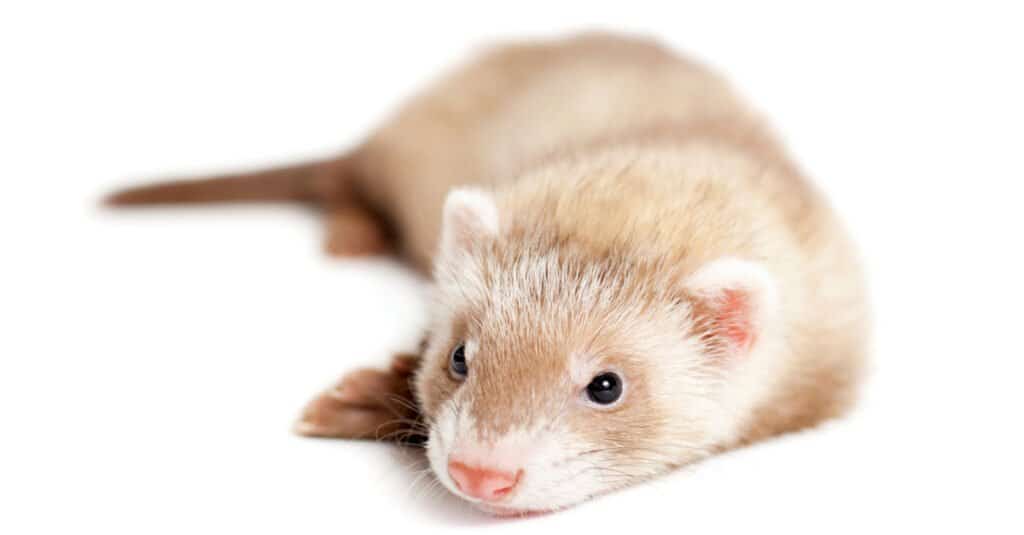
Sable ferrets were originally domesticated to hunt rabbits and vermin.
©Denis Kukareko/Shutterstock.com
The scientific name of the sable ferret is Mustela furo. This is the scientific name it shares with other ferrets. Mustela is Latin for “weasel” and furo is Latin for “cat” or “robber.” A synonym is Mustela putorius furo. Mustela putorius, the polecat is believed to be the ancestor of the domesticated ferret. By the way, putorius is Latin for “stench.”
History
Sable ferrets are descendants of European polecats (Mustela putorius). These critters may have been domesticated over 2,000 years ago in ancient civilizations. For example, they are thought to have aided Greeks and Romans with hunting, as well as controling rodent populations.
Ferrets gained popularity as mere lovable pets in the 20th century. People began to recognize their playful, charming natures, and breeders selectively developed their color variations. Sable ferrets eventually became one of the most popular among ferret enthusiasts.
Coloring
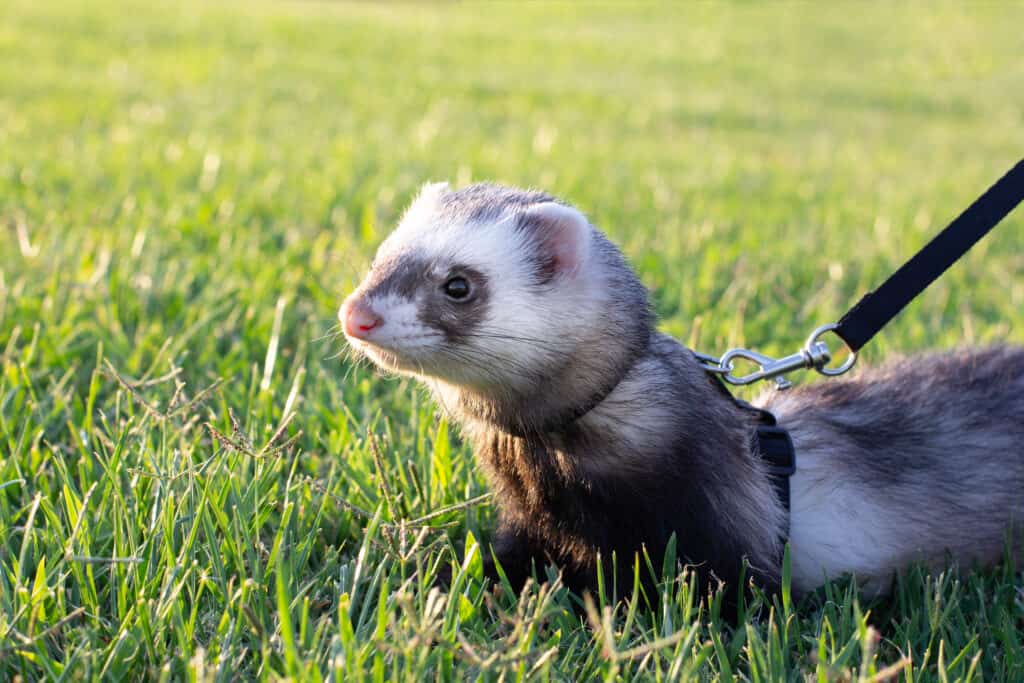
Sable ferret became popular as pets in the 20th century because of their charm and beautiful colorings.
©Irina Vasilevskaia/Shutterstock.com
There are different color morphs of sable ferrets, including the mask sable ferret and the mitt sable ferret. The standard sable Ferret has deep brown guard hairs over a paler undercoat. It is probably the same animal as the sable mask ferret because both of them have dark masks over their eyes. Not only this but the mask changes with the seasons and with the animal’s age. The mask may cover much of the animal’s face in the summer but only cover the eyes in the winter. The sable mitt ferret is the same as the other sable ferrets but has white feet.
The black sable ferret’s guard hairs are black as opposed to dark brown, but they also cover a lighter undercoat.
The sable ferret’s color patterns can also be a point or solid as well as standard. A solid ferret’s fur is one color, with no white or cream anywhere. Point ferrets have darker brown on their faces, feet, and tails in a way that recalls a Siamese cat.
The sable ferret is not the same as a Russian sable. The Russian sable is a relative of the ferret and is considered a type of marten. It is bigger than a ferret, with a body length of 14 to 22 inches with a 2.8 to 4.7-inch long tail. The Russian sable is a wild animal found in Russia, Mongolia, China, North Korea, and Japan. Unlike the sable ferret, it is an omnivore and does not make a good pet. It is illegal to own in some places.
Appearance
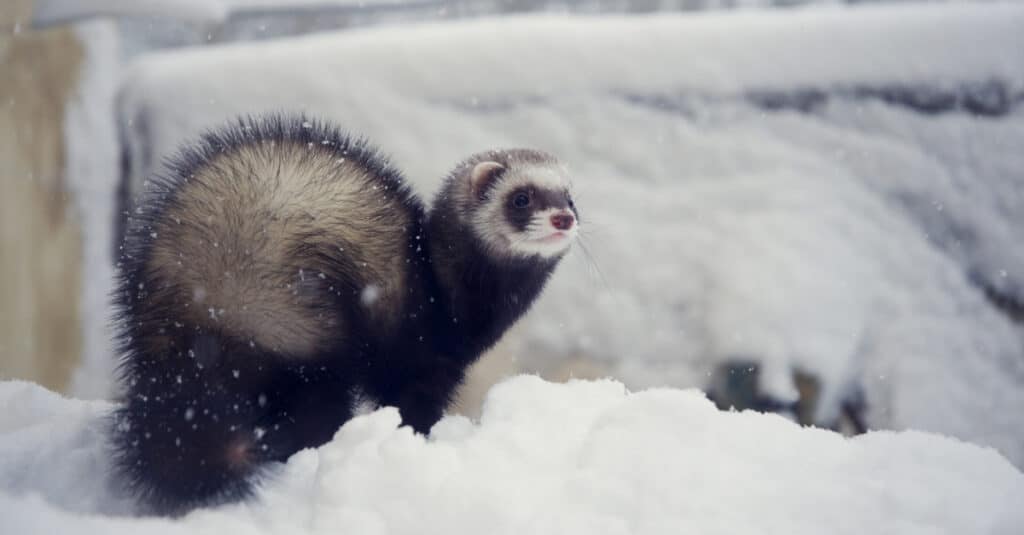
Sable ferrets are characterized by long, limber bodies
,
top fur all the same shade, with a distinctive dark mask on their faces.
©Yasmins world/Shutterstock.com
The sable ferret has the long, limber body of other ferrets as well as its ancestor the polecat. Traits that help in identification are an undercoat that ranges from white to brown and is covered with deep brown guard hairs. The colors of the fur are all the same shade, especially the head, the neck, and the body. Its eyes are black and are covered with a dark mask, and its nose can be mottled, black, or pink. Like other ferrets, the sable is about 20 inches long, weighs between 0.66 to 5.95 pounds, and males are bigger than females.
Sable mitt ferrets have white feet, and sable mask ferrets have the trademark mask over the eyes.
Like the polecat, the sable ferret has anal glands that it uses for scent marking and identification. Identification of one ferret by another can also be done through urinating.
Behavior
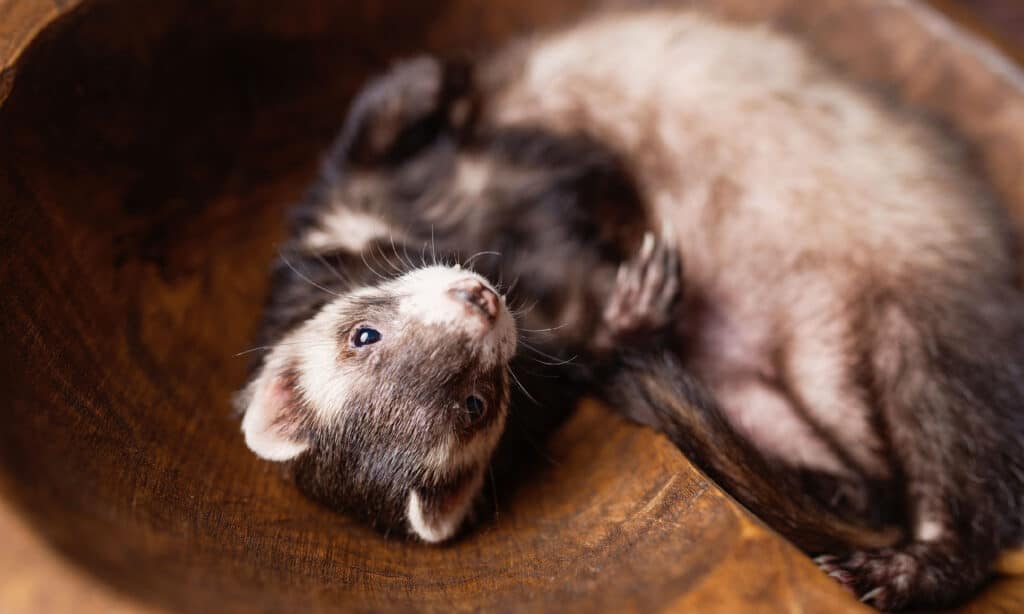
Sable ferrets are inquisitive and playful, but typically sleep 18-20 hours a day.
©iStock.com/Tatyana Consaul
This cute ferret is playful, inquisitive, and tidy, but it will sleep about 18 to 20 hours a day and be most active just when the sun rises and just after it goes down. How much it wants to play might depend on whether its human is around to interact with it. The sable ferret gets along with dogs and cats in the family but as a carnivore, it may be dangerous to have around pet birds and other creatures smaller than it is. It can be trained to do tricks and obey commands and can even be house-trained to do its business in a litter box. This is easy for the ferret to learn because it would use a specific spot to eliminate in the wild.
Owners of ferrets are delighted when they burst into what’s called a war dance. In this dance, they leap about and crash into things. It has nothing to do with war but simply means the ferret is happy and wants to play. If it has a ferret companion, they may play fight. The sable ferret has a large repertoire of sounds, including docks, clucks, screeches, squeaks, barks, and hisses.
Though polecats are solitary, ferrets will happily live together. They like to burrow and hide, so their enclosure or play area should have places where they can do this. The sable ferret also likes to sleep in a closed-in place, so a sleeping box should also be provided.
Habitat
The last wild ferret in North America is the black-footed ferret that lives underground in prairie dog towns. If members of M. furo lived in the wild, they would live in woods near bodies of freshwater. As a pet, the intelligent and energetic sable ferret needs as big an enclosure as is practicable. Since this cute ferret loves to chew on things, it’s best to get a metal cage. The cage also needs to be equipped with objects the ferret can explore, hide in, burrow through and play with as well as a litter box. Even with a large cage, a ferret needs to be let out for at least an hour or two to explore its larger environment and to play with its human.
Diet
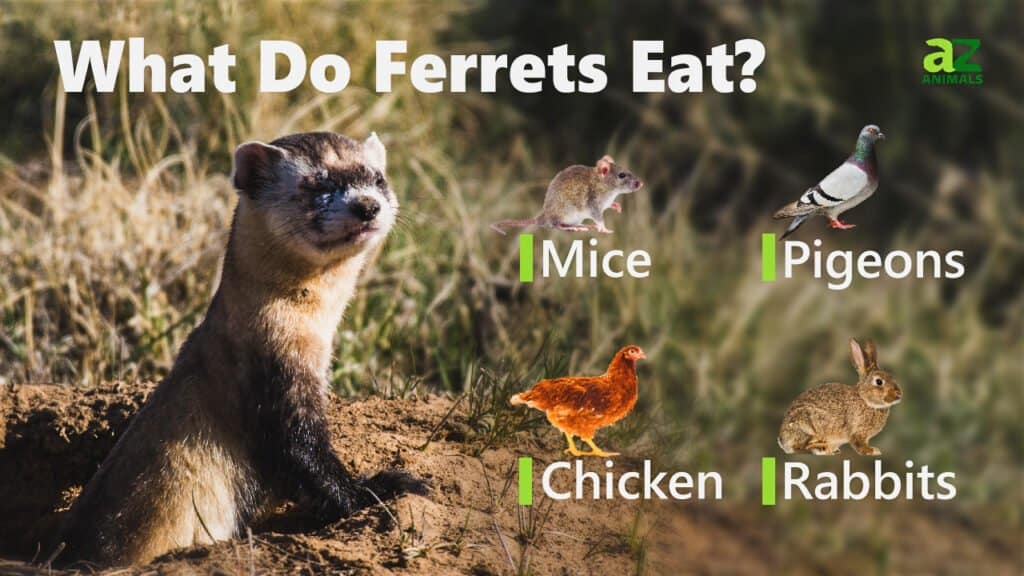
In the wild, ferrets prey on mice, rabbits, chickens, and other small birds like pigeons.
In the wild, a ferret would take small animals such as rabbits and mice and eat all of it, including its fur, skin, and viscera. Some pet owners do offer their ferrets freshly killed or even live animals, but this isn’t enough for a domestic ferret. Fortunately, there is food on the market that is made for ferrets and contains a healthy amount of taurine. The best ratio is 34 percent animal protein and 20 percent fat. Sable ferrets, like other members of M. furo do not process plant material well and shouldn’t be offered fruits or vegetables as treats. Instead, it is best to give them pureed baby food made of meat as a treat.
One thing to consider before buying a domesticated ferret is indeed its diet. The animal has such a fast metabolism that it needs to eat as much as 10 times a day.
Predators and Threats
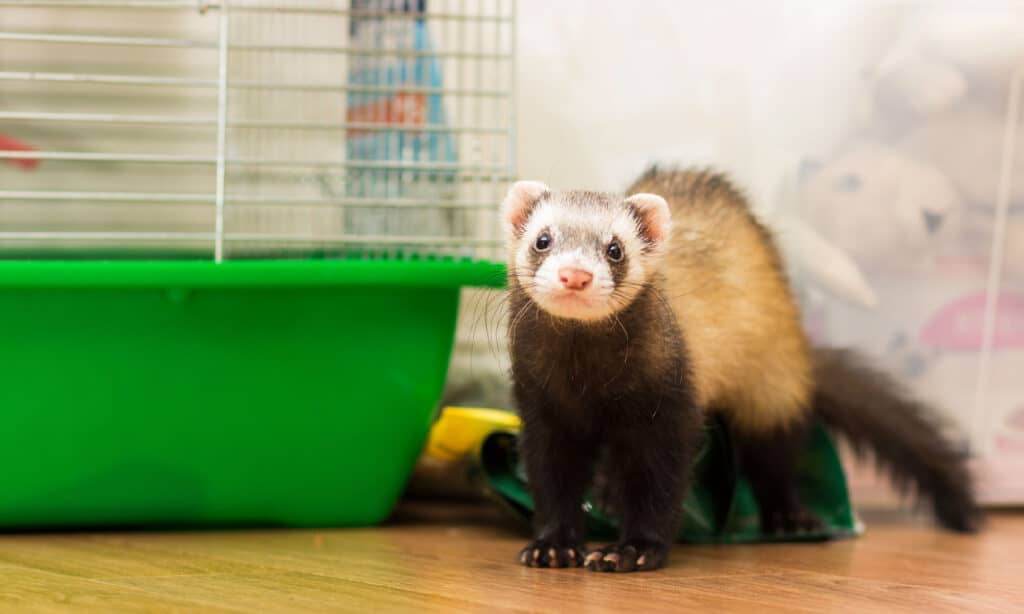
The biggest threat to a pet ferret comes in the form of health issues like cancer, virus, parasites, adrenal gland disorders, distemper, or dental problems.
©iStock.com/FaST_9
Because they are pets, these ferrets don’t have natural predators. If they did live in the wild, they would have to face predators such as birds of prey, coyotes, mountain lions, and other large carnivores.
The biggest threat to these ferret concern its health. Pet ferrets are unfortunately subject to many diseases and disorders. These include cancers and disorders of the adrenal glands. They can also suffer from viruses, parasites, canine and feline distempers, and problems with their teeth. They can also swallow objects that can obstruct their bowels and be subject to hairballs like pet cats.
Ferrets can also spread diseases to humans. It is important for a pet sable ferret to be vaccinated for rabies and other diseases.
Reproduction and Life Cycle
These ferrets are ready to mate when they’re about six months old, even though they’re not fully grown until they’re a year old. Male ferrets mate with many females, and females can have as many as three births a year. Some litters can have as much as 15 kits, and if the female has less than five kits, she will go into estrous even as she’s still nursing them. The ferret breeding season is usually between March and August.
The female is pregnant for about 42 days, and the kits are born helpless and blind. Their eyes do not open until they’re five weeks old, even as they are weaned when they’re between three and six weeks old. They have their permanent canines by the time they’re two months old and can eat kibble. Their mother stops caring for them at this time, and this is usually when a breeder sells them.
The lifespan of this cute ferret is between six and 10 years.
Population
It is estimated that there are at least 5 million pet ferrets in the United States alone. The sable ferret is the most popular.
View all 347 animals that start with S
They are obligate carnivores. This means they must have meat and cannot be healthy on a vegetarian diet.
A sable ferret is a member of the Mustela furo species. It is noted for its beautiful dark brown guard hairs over an undercoat of white, cream, gold, or brown and a mask over the eyes.
You can buy a sable ferret from a reputable breeder or even a pet store.
The colors of its eyes can be either dark brown or black.
This cute ferret is about 20 inches long including the tail.
The cost of a sable ferret is between 100and100 and 100and200. This needs to be added to the cost of an enclosure, food, toys, medical care, and of course the cost of child-proofing your house.
The rarest ferret is the black-footed ferret. It is endangered, and there are only 605 of them. Over half are in captivity. It isn’t the same species as the sable ferret. Its scientific name is M. nigripes. The rarest color found in M. furo is cinnamon.
Black sable ferrets make lovely pets. They are fun, funny, curious, and can be affectionate. This is also true of sable mask ferrets and sable mitt ferrets.
They usually live between six and 10 years.